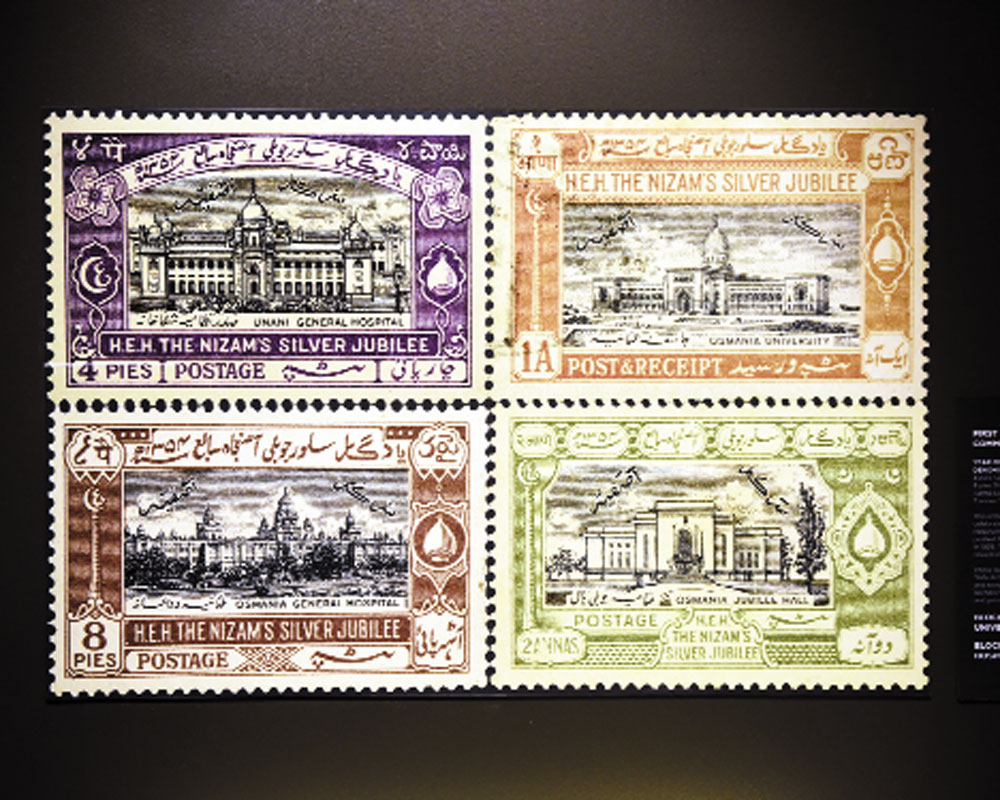For those who cannot get enough of the bygone eras, a collection of three million stamps from the dominion of the Nizam of Hyderabad packages a nostalgic delight. Story by Chahak Mittal
Emails and messages have altered the way we sit and communicate. Purchasing stamps to post letters has become a bygone practice. We have lost the art of detailing and the pleasure of waiting to instant communication. Nevertheless, nostalgia continues to be the favourite among the ones who lived it, and as well the ones who have only heard of it through their ancestors.
Presented by the Gujral Foundation, Property of a Gentleman, Stamps from the Nizam of Hyderabad’s Dominions, a US-based collector Hanut Ewari has inherited a collection of rare stamps and stamp sheets from his grandfather, Nawab Iqbal Hussain, who also served as the postmaster general of Hyderabad under the reign of seventh and last ruling Nizam of Hyderabad, Mir Osman Ali Khan. The exhibition, curated by Pramod Kumar KG, showcases the collection that has grown under the stewardship of Ewari with a plethora of stamps from across the globe.
Says Pramod, “The oldest stamp in the Ewari collection is from 1866. The collection consists of more than three million stamps and valuable, unusual and representative pieces from across what were called the princely states, including related paraphernalia such as blind and wet stamps, invitation cards, original letters, calligraphy art, postcards, revenue stamps of the region, erroneous stamps, seals and monograms.”
Given that the stamps hail from the 1860s, they were in a very good shape and properly maintained when he first looked at them. He says that it is also an evidence of how the paper used for these stamps has yellowed but didn’t decay through the years. “They were properly maintained and in a healthy condition. We didn’t have to restore any of it,” informs Pramod.
Well, archives and repositories are much more than just shelves stacked with historical records. They are a crucial collection of the different kinds of material cultures inherited over the ages. The curator, who has been associated with a few national archives since a long time, believes that India, being a country with vast diversity and history, can easily use and develop more archives for a deeper understanding of history and hence, a better development of the future. He feels that we don’t know how to use our archives appropriately and effectively. “Museums and archives are a record that this existed and in a particular way. If we look at them closely, we will learn about things that are completely forgotten or ignored in the modern-day advancements. I feel that archives should be more than just about oral histories or past incidents. There is a lot to record for future references like poetry, transition in language, artifacts, writings, graphic art and various other things not talked about today,” says he.
He narrates that when the Ewari family approached him for the curation and presentation of their collection, he felt it was important since it “is something that will talk about the print history of India. These stamps reflect the postal history and transition of visual and graphic arts in the country. With the technological advancement, these objects, which once played an essential role in the communication network, seem insignificant.” He says that it important to make the current generation realise that they were originally used as modes of payment to transfer messages and facilitate revenue collection, and taxation.
The exhibition also aims to help people take into account that apart from their fiscal purposes, many states also utilised them as a way of celebrating the material heritage and culture of their region. The stamps show the use of exquisite calligraphy in diverse languages and architectural tropes that existed in the erstwhile Hyderabad.
Well, one of the most special elements of the exhibition, Pramod says, is the “focus on the architecture of the Nizam’s dominion” on the stamps. The collection also includes the first stamp ever issued by the Nizam government in the city; a wide range of postage stamps in different colours, values, inscriptions and sizes; stamps featuring monuments from across the Nizam’s dominion as well as the last stamp issued by the princely state, with the most special one being the rare stamps issued in the city to commemorate the victory of the Allied Powers in the Second World War.
“There is also Penny Black (the first adhesive postage stamp in the world in 1840), and a King George VI series of Indian postage stamps depicting different modes of transportation used to deliver mail,” he adds.
(The exhibition is on till March 24 at Bikaner House.)
Writer: Chahak Mittal
Courtesy: The Pioneer








 OpinionExpress.In
OpinionExpress.In















Comments (0)